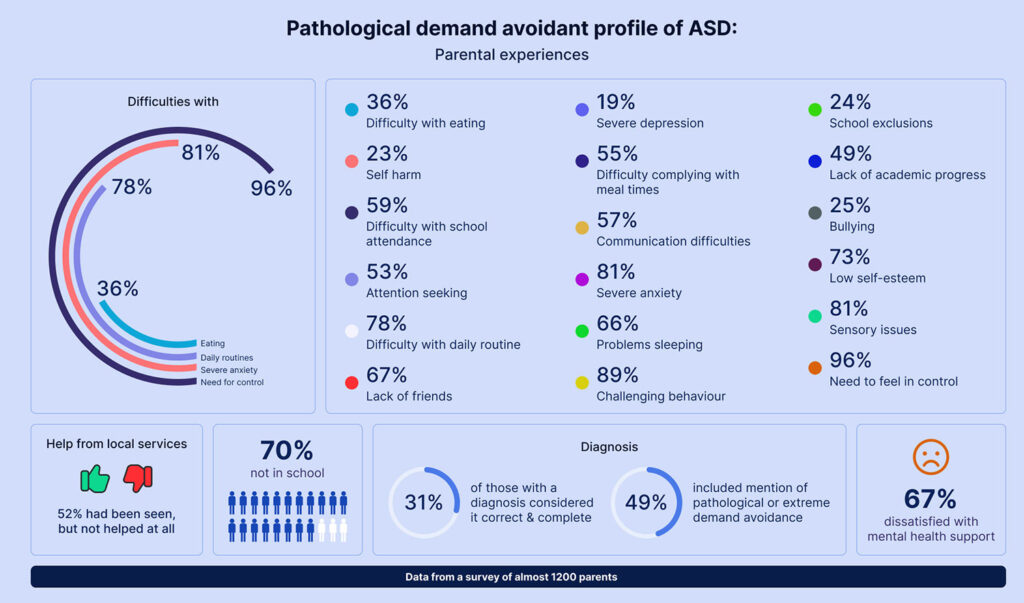Core Signs of Pathological Demand Avoidance
Extreme Resistance to Ordinary Demands
One of the hallmark signs of PDA is an individual’s disproportionate resistance to everyday requests and expectations that most people would comply with without issue. This resistance is not simply a preference but an anxiety-driven need to avoid demands. Individuals may react extremely to requests as simple as getting dressed or engaging in a classroom activity, perceiving these as unbearable impositions.
Example: A child might react with extreme distress to everyday requests like getting ready for school or sitting down for dinner. Instead of simple reluctance, the child may become extremely upset, attempt to negotiate out of the task, or become physically avoidant.
Verification Tip: Keep a record of these instances, noting the type of demands that trigger extreme reactions. Over time, a pattern may emerge that differentiates these reactions from typical childhood defiance, especially if these reactions are consistent across a range of seemingly simple requests.
Social Strategies to Avoid Demands
Individuals with PDA often exhibit a remarkable ability to use social manipulation as a means to evade demands. This can manifest as charming or flattering others, making excuses, changing the subject, or even lying. Such behaviors are strategies to control the situation and thus reduce their anxiety related to demands, rather than acts of deliberate defiance or manipulation for manipulation’s sake.
Example: When asked to tidy up their room, a child might try to charm their way out of it by complimenting the parent or suddenly engaging in affectionate behavior that is uncharacteristic in the context.
Verification Tip: Observe whether these social strategies are recurrent and specifically deployed to evade various demands. Consistency in using charm or negotiation primarily in response to requests can be a distinguishing feature of PDA.
Sudden Mood Swings and Impulsivity
The emotional responses of someone with PDA can be unpredictable and intense. They may experience sudden, severe mood swings or display impulsive behavior in an effort to escape or react to demands. These emotional outbursts are often misinterpreted as mere tantrums or deliberate provocations, but they are in fact manifestations of the underlying anxiety and stress the individual is experiencing.
Example: A child might be playing happily but suddenly becomes aggressively upset when a minor change occurs or a small request is made, such as turning off the TV.
Verification Tip: Monitor the frequency and triggers of these mood swings. Unlike typical mood changes, those associated with PDA often stem directly from encountering demands or anticipated demands, even if minor.
Preference for Role Play and Pretend
A distinctive sign of PDA is a strong preference for engaging in role play, fantasy, or pretend scenarios. Individuals might immerse themselves in imaginative play where they adopt various roles or personas. This behavior is not just a form of escapism; it represents a space where they feel in control, contrasting sharply with the real world where demands feel overwhelming and anxiety-provoking.
Example: A child spends a significant amount of time in elaborate pretend play, often insisting on others participating in specific roles or scenarios they control, especially when real-world demands are imminent.
Verification Tip: Note if the child retreats into role play as a means of control or avoidance when faced with daily tasks or changes in routine. The preference for fantasy over reality, particularly as a response to stress or demands, is a key indicator.
Challenges with Social Understanding and Empathy
Despite possibly presenting as highly verbal and socially adept in some contexts, individuals with PDA can struggle with genuine social understanding and empathy. Their interactions, though seemingly sophisticated, may lack depth in understanding others’ emotions or perspectives, particularly in situations that demand an authentic emotional connection or response.
Example: While a child with PDA might engage in what appears to be social behavior, they may misunderstand social cues or show a lack of genuine empathy in situations requiring emotional sensitivity.
Verification Tip: Observe interactions with peers or during family situations that require empathy or understanding of social nuances. Misinterpretations or superficial engagements, especially if the child otherwise appears socially competent, may signal PDA.
Obsessive Behaviors Focused on People
Unlike other profiles on the autism spectrum where interests may center on objects or specific topics, those with PDA tend to develop intense, often changeable obsessions focused on people. This can involve fixating on a peer, celebrity, or fictional character, sometimes mimicking these individuals or incorporating them into their role play. These obsessions can serve as another strategy to avoid demands, providing a mental escape into a more controllable and less anxiety-inducing world.
Example: A child develops an intense fixation on a classmate, teacher, or fictional character, wanting to know everything about them or insisting on talking about them constantly, often to the exclusion of other interests.
Verification Tip: Track the focus and intensity of the child’s interests, particularly if they rapidly shift between people or if these fixations are used to divert conversations away from demands or expectations.

PDA and Its Relation to Autism
PDA is increasingly recognized within the context of the autism spectrum, highlighting the diversity of autistic presentations. The core feature of PDA—avoidance of everyday demands due to anxiety—sets it apart from other profiles within the spectrum. Unlike other forms of autism where routines and predictability may reduce anxiety, individuals with PDA may find these same structures overwhelmingly restrictive. Understanding PDA as part of the autism spectrum emphasizes the need for tailored support strategies that appreciate the unique challenges faced by those with PDA.

Strategies for Managing PDA
Embracing Flexibility
One of the cornerstones of managing PDA is flexibility. Reducing the perception of demands can alleviate anxiety and resistance. This involves adapting communication and expectations, such as offering choices instead of direct orders and framing tasks as collaborative activities.
Creating a Low-Demand Environment
Creating an environment that minimizes perceived demands can help individuals with PDA feel more in control, reducing their anxiety and oppositional behavior. This doesn’t mean eliminating all structure but rather adjusting it to be more negotiable and less directive.
Fostering Positive Relationships
Building trust and understanding is crucial. Strategies should focus on developing a rapport that acknowledges the individual’s need for autonomy while gently encouraging engagement. Positive reinforcement and focusing on strengths can promote cooperation.
Utilizing Special Interests
Leveraging the individual’s interests or obsessions as motivators can be an effective strategy for engagement and learning. This approach can help bypass resistance by embedding demands within contexts that the individual finds appealing.
Seeking Professional Support
Professional guidance from psychologists, therapists, or specialists in autism and PDA can provide invaluable support and tailored strategies. They can offer insights into managing behaviors, reducing anxiety, and improving the individual’s and family’s quality of life.
Empowering Your Child at Home
Parents can play a pivotal role in supporting their child by adopting strategies that recognize and accommodate the unique challenges of PDA. This includes practical steps at home to create a supportive environment, using clear, choice-based communication, and fostering a positive, understanding relationship that prioritizes the child’s sense of control and autonomy.

General Tips for Parents:
- Documentation: Keep a detailed log of behaviors, triggers, and responses, as patterns over time can provide clearer insights than isolated incidents.
- Professional Consultation: Share your observations with professionals experienced in autism and PDA. They can offer assessments and insights that help distinguish PDA from other behavioral or developmental conditions.
- Peer Comparison: While all children are unique, observing how your child’s reactions to demands compare with those of peers can highlight discrepancies in behavior.
- Parental Intuition: Trust your instincts. Parents often have a deep understanding of their child’s behaviors and can sense when reactions don’t align with typical developmental challenges.
Recognizing PDA involves piecing together a mosaic of behaviors and responses that, when viewed as a whole, depict a distinct profile. This process is nuanced, requiring patience and understanding, but with careful observation and professional support, parents can navigate this journey more confidently.







